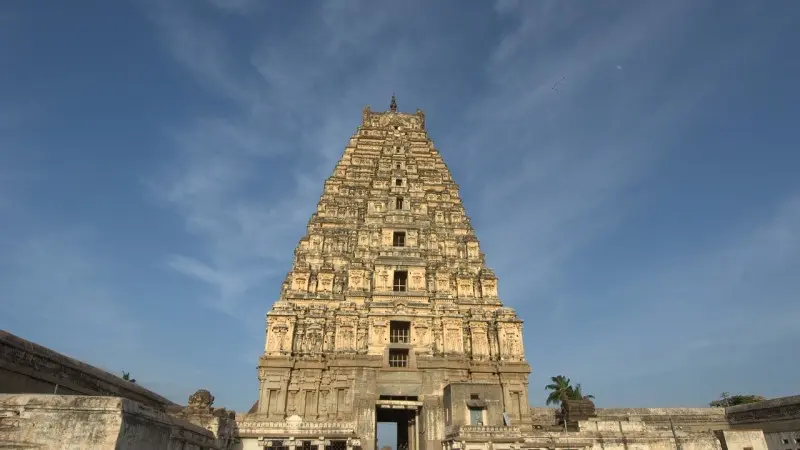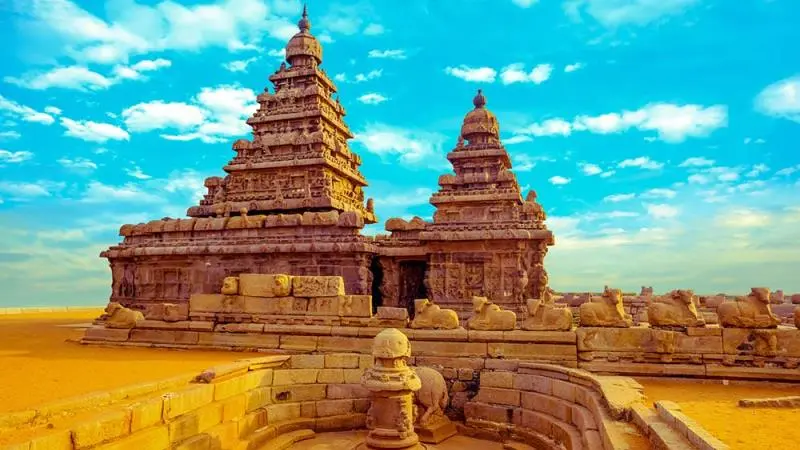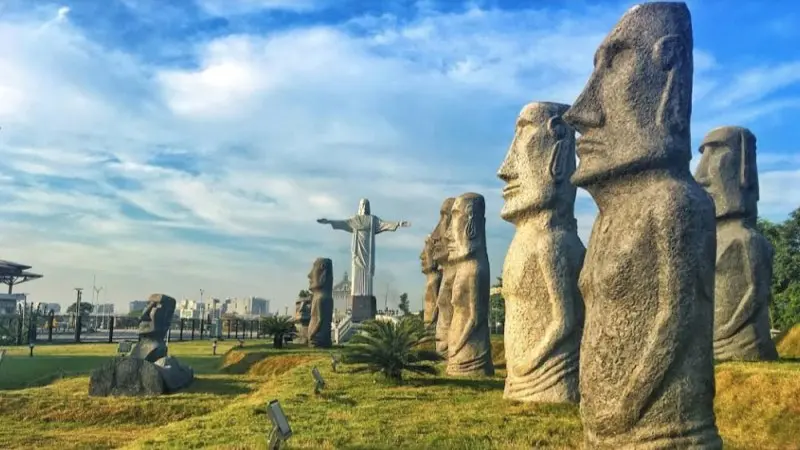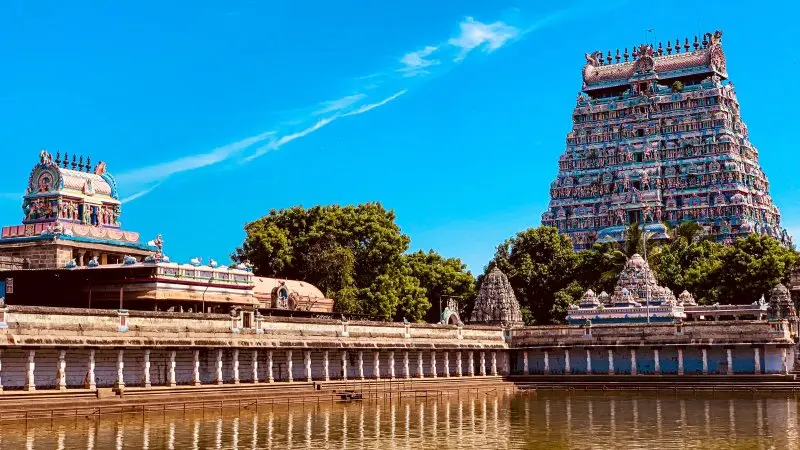| Entry Fee: 50 INR; Location: Check Map Address: Hampi, Karnataka 583239, India. |
Located in the ancient and historical town of Hampi, in the southern Indian state of Karnataka, the Virupaksha Temple is one of India’s most sacred and architecturally significant temples. Dedicated to Lord Shiva, known here as Virupaksha, the temple has been an important pilgrimage site for centuries.
The Virupaksha Temple, along with the group of monuments at Hampi, was declared a UNESCO World Heritage Site in 1986. The temple’s intricate architecture, historical significance, and its continuous functioning as a religious site for more than a millennium contribute to its recognition as a World Heritage Site. Today, it stands not only as a testament to Hampi’s glorious past but also as an enduring symbol of India’s rich cultural and spiritual heritage.
History of Virupaksha Temple
1. Origin and Ancient History of the Temple
The Virupaksha Temple has a history that dates back to the 7th century, making it one of the oldest functioning temples in India. Originally a small shrine, it was gradually expanded into a large complex under the patronage of various rulers of the region.
2. Changes and Expansions Over the Centuries
Significant expansions to the temple were made during the reign of the Vijayanagara Empire, particularly during the rule of King Krishnadevaraya in the 16th century. It was during this time that the temple complex’s grand entrance towers, or gopuras, and many of its pillared halls were constructed.
3. Role in the Vijayanagara Empire and Its Significance
The Virupaksha Temple held an important place in the Vijayanagara Empire. The city of Hampi was the empire’s capital, and the temple was at its core. The annual festivals and rituals held at the temple were grand affairs and attracted devotees from across the region. Today, the ruins of the empire surrounding the temple bear testimony to the grandeur of the Vijayanagara period and the central role of spirituality in its society.
Virupaksha Temple Architecture
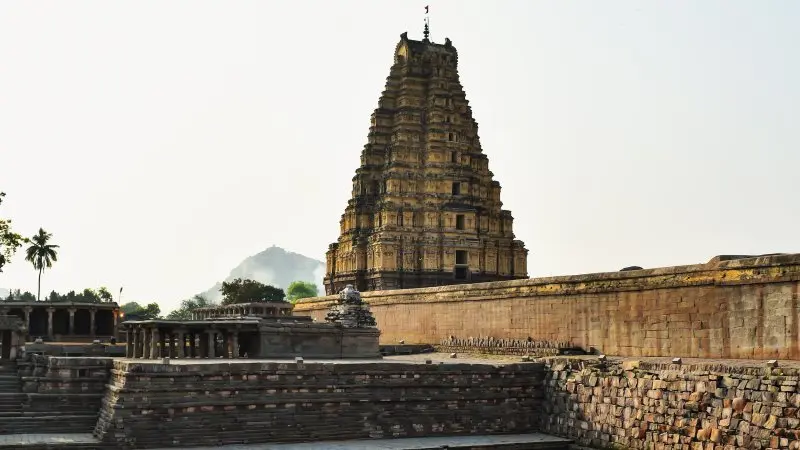
1. Temple’s Main Structures: The Gopuras, Sanctum, Pillared Halls
The Virupaksha Temple complex includes several notable structures. Its three towering gopuras (temple towers) dominate the landscape. The largest, the eastern gopura, stands at a height of 50 meters and is a masterpiece of Vijayanagara architecture.
The sanctum sanctorum, where the deity Virupaksha (Shiva) is enshrined, is the oldest part of the temple. The temple also has a separate shrine dedicated to Pampa Devi, Shiva’s consort.
Several intricately sculpted pillared halls, including the grand Ranga Mandapa added in 1510 AD, are significant features of the temple. These halls served various ceremonial and social functions.
2. Unique Architectural Elements and Sculptures
The temple is celebrated for its elaborate carvings and sculptures depicting Hindu deities, mythological creatures, and scenes from ancient epics like the Ramayana and the Mahabharata. A unique feature of the temple is the usage of mathematical concepts and geometry in the design and layout of certain architectural elements.
3. The Mural Paintings of the Temple
The ceilings of the Virupaksha Temple feature mural paintings of Shiva, Parvati, and other Hindu deities. Though faded with time, these murals add to the temple’s artistic significance and offer a glimpse into the artistic traditions of the Vijayanagara period.
4. Features of Dravidian Architecture Present in the Temple Design
The Virupaksha Temple is a prime example of Dravidian architecture, characterized by its square-shaped sanctum, circumambulatory path, pillared halls, and lofty entrance towers. The use of local reddish-brown granite and the focus on verticality are distinctive of this architectural style.
Religious Significance
1. Worship of Lord Shiva as Virupaksha and Pampa Devi
The Virupaksha Temple is a significant place of worship dedicated to Lord Shiva, who is venerated here as Virupaksha, and his consort Pampa Devi. According to legend, it is here that Shiva and Pampa Devi were married, giving the site a special spiritual significance. This makes it a particularly important pilgrimage site for followers of Shiva.
2. Rituals and Ceremonies Performed at the Temple
Daily rituals at the temple include various forms of worship, such as abhishekam (sacred bath), alankaram (decoration of the deity), naivedyam (food offering), and arati (waving of lamps) among others. The temple also performs special pujas on significant days in the Hindu calendar.
3. Major Religious Festivals and Celebrations Held Annually
The Virupaksha Temple is the epicenter of many religious festivals and events. The most significant is the annual chariot festival, held in February or March, which attracts thousands of pilgrims and tourists. During this festival, the temple’s idols are placed in large chariots and paraded through the streets of Hampi.
Another major event is the marriage anniversary of Virupaksha and Pampa celebrated every December, known as the Pampa Utsava. These festivals are marked by grand processions, cultural performances, and rituals, providing a glimpse into the rich spiritual traditions associated with the temple.
Virupaksha Temple and Tourism
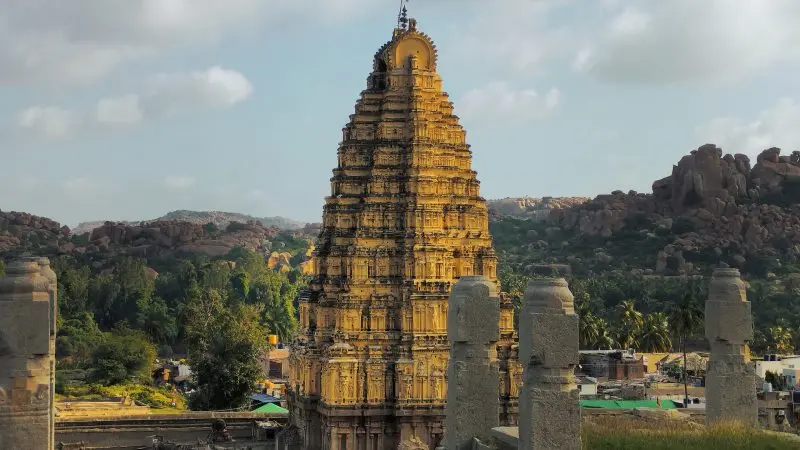
1. Importance of the Temple for Tourism in Hampi
The Virupaksha Temple is a cornerstone of Hampi’s tourism. Its historical significance, architectural grandeur, and religious importance attract tourists and pilgrims from all around the world. The temple’s iconic gopuras, sculptured walls, and mural paintings provide a unique opportunity to experience the rich heritage of the Vijayanagara Empire.
2. Nearby Attractions for Tourists
There are numerous other attractions in Hampi that visitors to the Virupaksha Temple may also explore. These include the Vijaya Vittala Temple with its famous stone chariot, the Royal Enclosure, Hemakuta Hill Temples, and the Hampi Bazaar. The Tungabhadra River, with its ancient ghats and coracle rides, offers a serene contrast to the grandeur of the temples.
3. Conservation Efforts and the Role of UNESCO
Recognizing its immense cultural value, UNESCO declared the Virupaksha Temple and the surrounding Hampi monuments a World Heritage Site in 1986. Conservation efforts are ongoing to preserve these monuments. UNESCO, in conjunction with the Archaeological Survey of India, has implemented several measures to protect and preserve the integrity of the site while also promoting sustainable tourism.
Conclusion
The Virupaksha Temple, with its grand gopuras, intricate carvings, and ancient murals, represents an important chapter in India’s rich historical and architectural narrative. As one of the country’s oldest functioning temples, it bears testament to the enduring legacy of the Vijayanagara Empire and the profound spiritual traditions of Hinduism.
In the present day, the Virupaksha Temple serves multiple roles – as a place of worship, a historical monument, and a major tourist attraction. It continues to be a hub of religious activities, drawing devotees from far and wide. As a UNESCO World Heritage Site, it forms an essential part of the global cultural heritage, attracting tourists and history enthusiasts. The temple’s ongoing significance illustrates how, despite the passage of centuries, it remains deeply rooted in the cultural and spiritual fabric of India.

